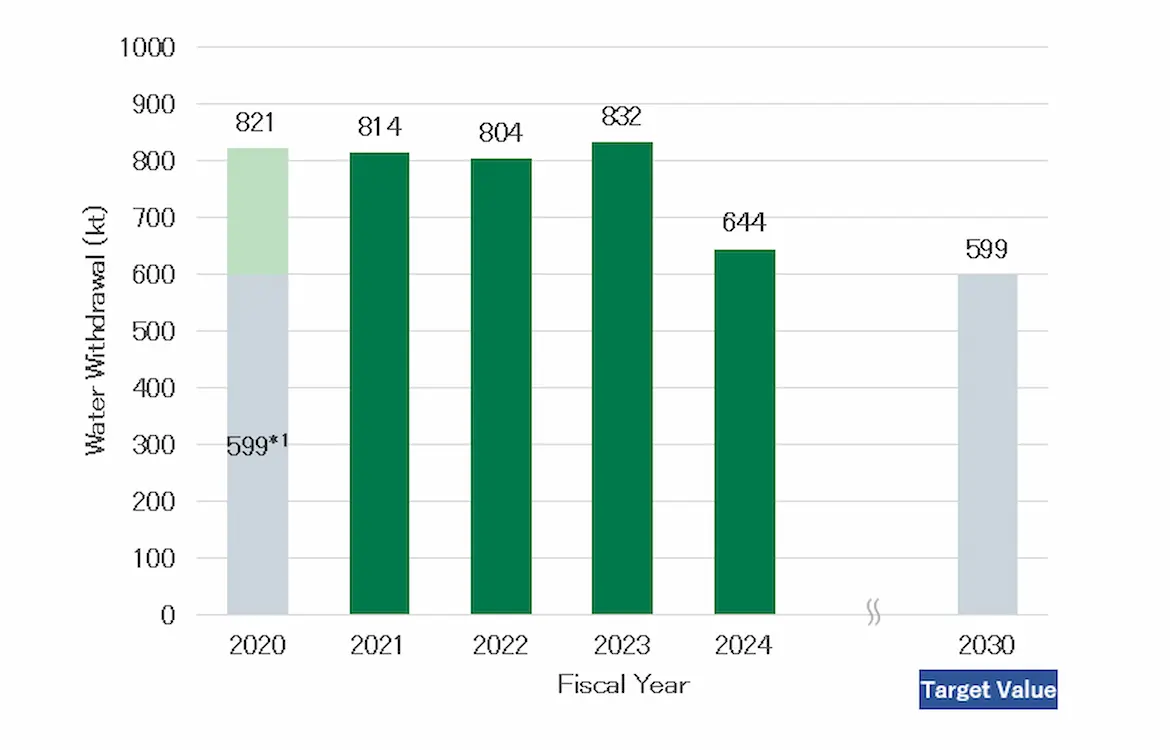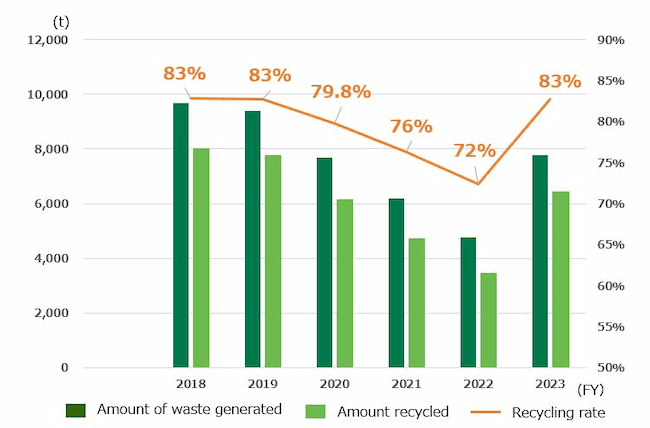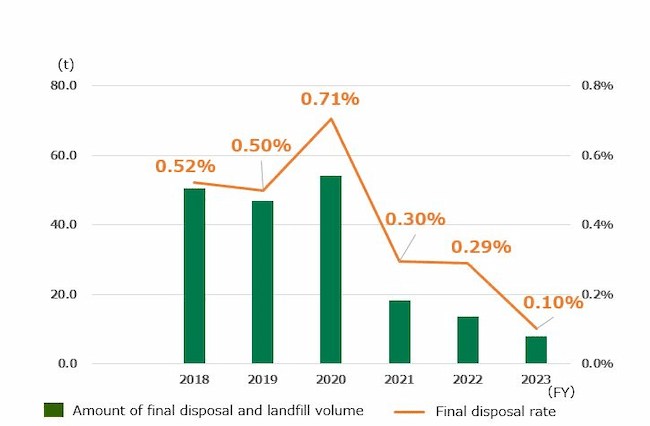Water・Resource Circulation
Effective Use of Water Resources
Good quality and sufficient quantities of fresh water are essential for our business activities, including the manufacturing of pharmaceutical products. As problems related to water resources are becoming increasingly serious worldwide, Sumitomo Pharma has set a Medium- to Long-term Environmental Goals of "reducing water withdrawal to below the fiscal 2020 level (599 kt*1) by fiscal 2030," in order to use water resources in a sustainable manner. Moreover, we believe that reducing water withdrawal leads to the protection of water sources and it is therefore an activity that indirectly contributes to the conservation of biodiversity.
We monitor and manage the water withdrawal and discharge across all business sites in the Sumitomo Pharma Group, excluding small-scale offices such as tenant offices. To effectively utilize water resources, we have introduced water-saving equipment such as water-saving nozzles on faucets in animal breeding rooms, and implemented operational improvements, including reviewing the frequency of equipment and facility cleaning and optimizing air conditioning operations. In fiscal 2024, water withdrawal decreased compared to the previous fiscal year due to the downsizing of active pharmaceutical ingredient (API) manufacturing functions at our domestic production sites. We will continue our efforts to reduce water withdrawal through pursuing greater efficiency in water usage and water saving measures.
For more information on the progress of the Medium- to Long-term Environmental Goals, please see "Environmental Goals and Performance."
Water Withdrawal Reduction Targets and Transition (Non-Consolidated)

- *1Amount of water withdrawal in fiscal 2020, excluding water used at the downsized API manufacturing division.
Water Withdrawal by Source (Consolidated)
Boundary of calculation:
Consolidated basis (Sumitomo Pharma
Co., Ltd., consolidated subsidiaries in Japan, overseas consolidated
subsidiaries). However, small offices such as branches and business
offices are excluded. In addition, overseas consolidated
subsidiaries that do not have production sites or major research
facilities are excluded from the scope because they have only small
offices.
For more information on the calculation criteria,
please see
"ESG Data Table."
Water Discharged and Breakdown by Discharge Destination (Consolidated)
Boundary of calculation:
Consolidated basis (Sumitomo Pharma
Co., Ltd., consolidated subsidiaries in Japan, overseas consolidated
subsidiaries). However, small offices such as branches and business
offices are excluded. In addition, overseas consolidated
subsidiaries that do not have production sites or major research
facilities are excluded from the scope because they have only small
offices.
For more information on the calculation criteria,
please see
"ESG Data Table."
Addressing Water Risks
As concerns about water risks increase worldwide, the Group regularly assesses risks pertaining to current and future water stress and vulnerability of the downstream environment at our domestic and overseas production and research sites using databases such as Aqueduct, the water risk assessment tool of the World Resources Institute (WRI), and the Integrated Biodiversity Assessment Tool (IBAT), which measures biodiversity risk. We utilized the Intergovernmental Panel on Climate Change (IPCC) Representative Concentration Pathways (RCP) 8.5 scenario (the high-level reference scenario) for simulations to predict future river basin water supply volumes. In addition, through interview surveys of staff at our production and research sites and other methods, we have studied water-related problems that have actually occurred at each site in the past as well as future region-specific issues. Based on a comprehensive analysis of these findings, we considerthe risks related to the current water supply and downstream environmental vulnerability to be low.
In line with the recommendations of the Task Force on
Climate-related Financial Disclosures (TCFD), we conduct analyses
and assessments of water-related risks associated with climate
change, including water-related disasters, as well as water-related
opportunities. Based on these insights, we are taking concrete
actions to mitigate these risks.
For more information, please
see
"Information Disclosure Based on TCFD Recommendations (Response
to Climate Change)."
As part of our value chain risk management, we continue to evaluate water risks of important raw material manufacturers and contract manufacturers using Aqueduct. Additionally, based on the "Sustainable Code of Conduct for Business Partners," we conduct the sustainability evaluation to confirm the status of the implementation of these guidelines by our business partners, including suppliers. In these assessments, we use a "Sustainability Survey" to understand the water withdrawal, water discharged, management of pollutants in wastewater, and water-saving/recycling initiatives of our business partners. Moving forward, we will deepen communication with our business partners and work to reduce water risks across the entire value chain.
For more details on the Sustainability Survey, please see "Together with Business Partners" and "Environmental Communications."
Results of water risk assessment using WRI Aqueduct (Target; our group production and research sites)
Fiscal 2024 Water Stress Assessment (April 1, 2024 to March 31, 2025)
| Level of water stress | Japan | Overseas | ||
|---|---|---|---|---|
| Number of sites | FY2024 water withdrawal (kt) | Number of sites | FY2024 water withdrawal (kt) | |
| Low(<10%) | ー | ー | ー | ー |
| Low - Medium(10-20%) | 5 | 639 | 1 (U.S.) | 7 |
| Medium - High(20-40%) | ー | ー | ー | ー |
| High(40-80%) | ー | ー | ー | ー |
| Extremely High(>80%) | ー | ー | 1 (China) | 24 |
| Total | 5 | 639 | 2 | 32 |
Resource Circulation
To make effective use of limited resources, Sumitomo Pharma
continues to actively practice the "3Rs" of waste management
(reduce, reuse, recycle) under the Medium- to Long-term
Environmental Goals.
In fiscal 2024, we achieved our targets
for recycling rates and final disposal rate, continuing the progress
made in fiscal 2023. Furthermore, material recycling of blister
packaging waste*2, which was initiated in fiscal 2023,
made a significant contribution, enabling us to exceed our target
plastic recycling rate of 65% for the first time in fiscal 2024.
In addition we are promoting the following actions to reduce waste and promote recycling:
- Recycling of non-dispersive asbestos-containing waste, which was previously subject to final disposal
- Active adoption of environmentally friendly containers and products, such as bottle cans, in vending machines at each business site, as part of efforts to reduce PET bottle usage
- Sale of unused laboratory equipment to promote reuse*3
- Participation in a recycling initiative using the material recycling platform operated by Askul Corporation in which used plastic folders are collected for recycling*4
-
*2 Sumitomo Pharma and ORIX Eco
Services to Collaborate on Recycling Blister Packaging Waste at
Suzuka Plant
Press Release: https://www.sumitomo-pharma.com/news/20231120.html - *3 ZAI Reuse Market for Scientific Equipment: https://science.zai.market/(in Japanese only)
- *4 ASKUL Resource Circulation Platform: https://www.askul.co.jp/kaisya/shigen/(in Japanese only)
Going forward, we will actively pursue recycling through thorough waste separation, conversion of waste into valuable resources and outsourcing to waste disposal companies who are capable of recycling.
For more information on the progress of the Medium- to Long-term Environmental Goals, please see "Environmental Goals and Performance."
Waste-related Indicators
Recycling Rate

Final Disposal Rate

Boundary of calculation: Sumitomo Pharma Co., Ltd. only (branches and business offices are excluded)
For more information on the calculation criteria, please see "ESG Data Table."
Recycling of Product Containers and Packaging Materials
In accordance with the Containers and Packaging Recycling Act,
Sumitomo Pharma recycles some of the containers and packaging
materials used for our products.
Going forward, we will also
fulfill our obligation to recycle containers and packaging, and
actively work on reducing the amount of packaging materials used and
replacing them with renewable resources.
Product Packaging Material Usage, Outsourced Recycling Amounts*5 (Fiscal 2023 results)
| Product packaging materials | Usage (t) | Outsourced recycling amount (t) |
|---|---|---|
| Plastic | 270 | 77 |
| Glass | 38 | 10 |
| Paper | 203 | 4 |
Total cost of outsourced recycling: 5,136,000 yen
- *5Outsourced recycling amounts are calculated based on coefficients for calculating mandatory recycling amounts determined by the Japanese Government.